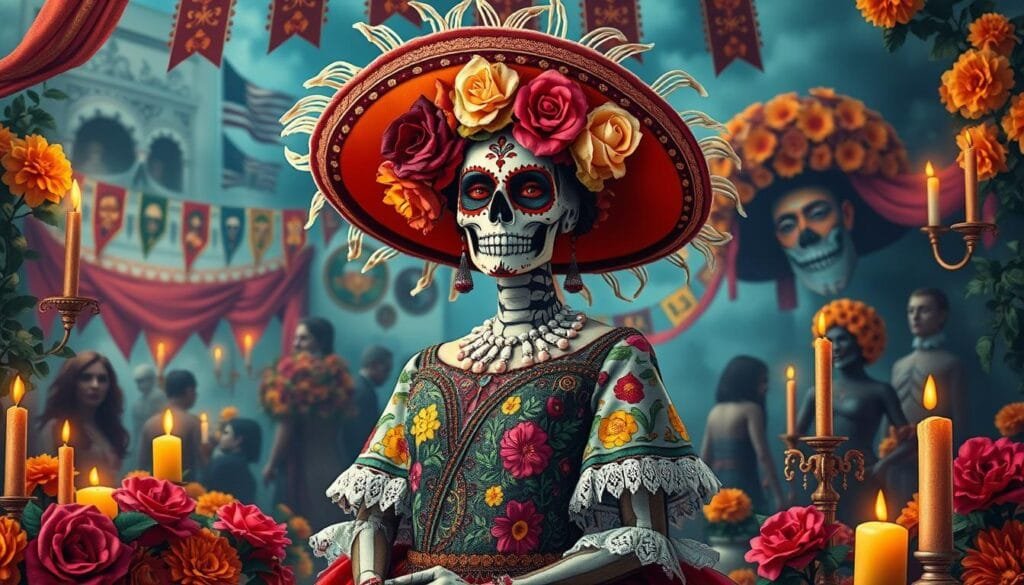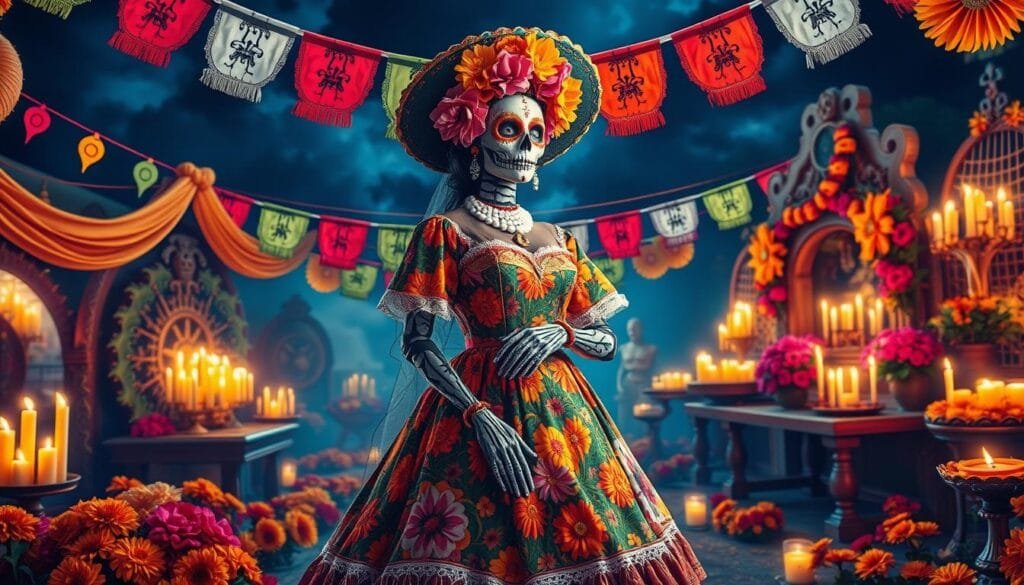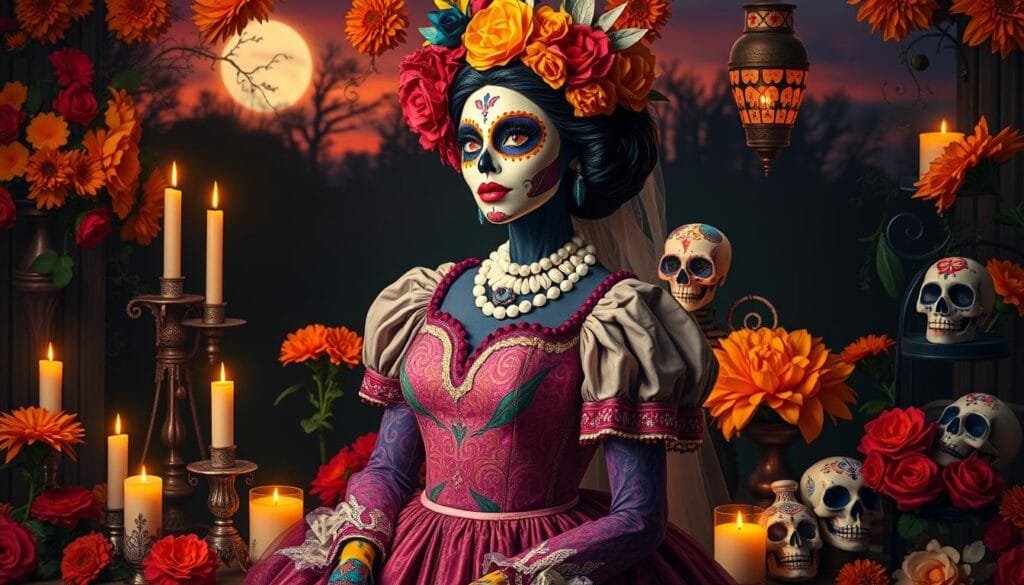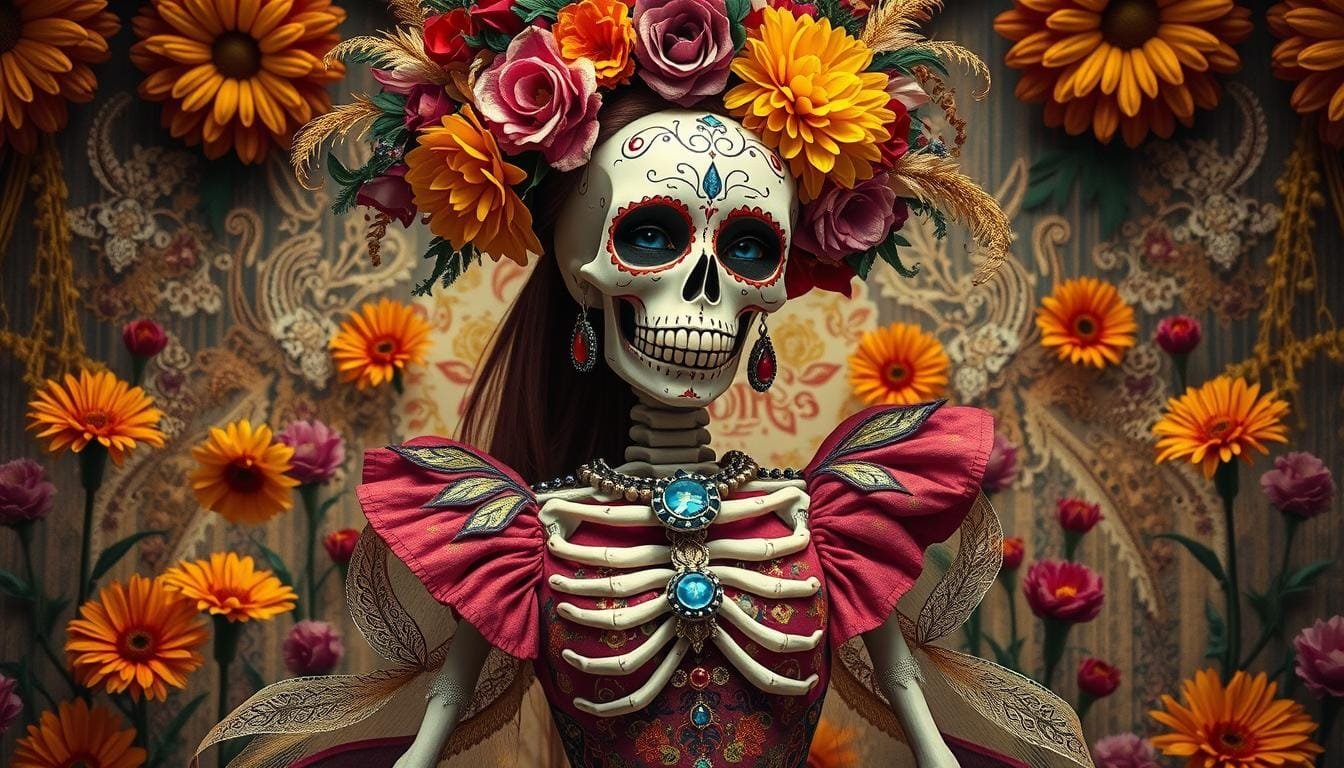Have you wondered about the elegantly dressed skeleton at Mexico’s Day of the Dead? It started during the Mexican Revolution’s upheaval. La Calavera Catrina was made by José Guadalupe Posada in 1913. Her story mixes social critique with cultural roots.
This skeletal lady is noted for her fancy clothes and high-class air. She comments deeply on the social and economic gaps of her era. More than a spooky Day of the Dead icon, she symbolizes satire mixed with tradition. This makes her a key Mexican symbol.
La Calavera Catrina began as a joke about Mexico’s rich during Porfirio Diaz’s rule. How did she become a beloved part of the Day of the Dead’s fun and thoughtful celebration?
Key Takeaways
- La Calavera Catrina was created in 1913 by José Guadalupe Posada.
- Initially named “La Calavera Garbancera,” the figure was a satirical critique of Mexico’s upper class.
- The skeleton has evolved into an iconic symbol of the Day of the Dead celebrations.
- La Catrina reflects vanity and societal disparities during a period of social struggle.
- Her transformation into a cultural emblem blends historical critique with festive traditions.
The History of La Calavera Catrina
La Calavera Catrina’s story is woven into Mexican culture and political history. José Guadalupe Posada, a famed illustrator, created her in 1910. Originally called “la calavera garbancera,” she was a critique of Mexicans who denied their roots for European ways.
During the dictatorship of Porfirio Díaz, which lasted from 1876 to 1911, Posada’s work stood out. He opened his workshop in Mexico City in 1888. His art, full of sharp social commentary, symbolized the Mexican Revolution. It challenged the social divide.
Diego Rivera played a big role in shaping the image of La Catrina we know today. In his 1947 masterpiece “A Dream of a Sunday Afternoon in the Alameda Park,” he featured her as a national symbol. She stood with famous Mexican figures, highlighting her importance in Mexican culture.
Over years, La Catrina has become a familiar figure in Mexican tradition. From European dresses to being styled with floral crowns, huipiles, and charro suits, she reflects a shift towards valuing indigenous heritage.
Now, La Catrina is a key part of Día de los Muertos, representing death’s democracy and life’s celebration. She underscores Posada’s impact on Mexican culture. About 55% of Mexicans observe Día de los Muertos, where La Catrina, in various outfits, reminds us of Mexico’s vibrant culture.
| Aspect | Details |
|---|---|
| Creator | José Guadalupe Posada |
| Year of Origin | 1910 |
| Original Name | La Calavera Garbancera |
| Cultural Significance | Critique of Classism |
| Iconic Transformation | Diego Rivera’s 1947 Mural |
| Modern Representation | Icon of Día de los Muertos |
Symbolism Behind La Calavera Catrina
La Calavera Catrina was created by José Guadalupe Posada between 1910-12. She symbolizes important aspects of Mexican culture. At first, she was a humorous jab at Mexico’s wealthy people, pointing out issues that are still talked about today.

Critique of High Society
Posada used La Calavera Catrina to critique society’s obsession with looking European, while forgetting Mexican roots. She was called “La Calavera Garbancera” back then. Her image shows that beneath fancy clothes, everyone is mortal.
In his mural “Sueño de una Tarde Dominical en la Alameda Central,” Diego Rivera gave her an iconic status. She stands with famous personalities like Frida Kahlo and José Martí, adding depth to discussions on class and identity.
Connection to Aztec Mythology
La Catrina goes beyond social critique and connects with Aztec mythology. She relates to Mictecacihuatl, the goddess overseeing death, highlighting the endless cycle of life and death. This shows the cultural and historical significance of La Catrina.
La Catrina represents a wide range of symbolism in Mexican culture. From Posada’s original etchings to her role in modern art and celebrations, she symbolizes Mexico’s history and beliefs.
- La Calavera Catrina first appeared as a zinc etching by José Guadalupe Posada around 1910-12, with a confirmed publication date in 1913.
- Diego Rivera’s mural “Sueño de una Tarde Dominical en la Alameda Central” includes La Catrina and stretches 15 yards, depicting 400 years of Mexican history.
- Posada’s “La Calavera Garbancera” critiqued the Mexican elite for adopting European fashions over indigenous heritage.
| Year | Event | Significance |
|---|---|---|
| 1910-12 | Posada’s Zinc Etching | Introduction of La Calavera Catrina, highlighting critique of vanity |
| 1913 | Broadside Publication | Broadened exposure during Day of the Dead |
| 1944 | Art Institute of Chicago | Increased visibility in the U.S. market |
Icon of Día de los Muertos
La Catrina stands as a powerful symbol of Día de los Muertos. This Mexican holiday merges joy with remembrance. José Guadalupe Posada created her in 1910. Initially called “La Calavera Garbancera,” she critiqued social norms of the era. Now, she symbolizes deep joy.
Today, Día de los Muertos is known worldwide for its lively traditions. La Catrina appears in men’s and women’s formal wear, on altars, and in sugar skulls. Diego Rivera immortalized her in his 1947 mural, emphasizing her role in Mexican culture.
The Day of the Dead blends Aztec beliefs and Mexican traditions. It involves a journey to Mictlán. La Catrina, with her attire and makeup, teaches a joyful view of death. She promotes equality in death with “Todos somos calaveras [We are all skulls].”
La Catrina has moved from social critique to a beloved Día de los Muertos icon. Over 90% of the festival’s fans use her image in celebrations. Movies like “Coco” and “The Book of Life” have boosted her fame and merchandise sales.
Engaging with La Catrina helps us connect to Mexican holiday traditions. Her worldwide appeal shows how cultural icons can build bridges between diverse groups.
Who Is the Most Popular Iconic Skeleton in Mexican Culture?
La Catrina was made by José Guadalupe Posada between 1910-1913. She’s the top iconic skeleton in Mexican culture. First called “Calavera Garbancera,” she reflected indigenous street food culture. Now, she represents much more than just history.
Transformative Influence
La Catrina’s impact goes beyond her initial role. She critiques high society and shows social gaps. The idea is “Death is democratic.” Diego Rivera made her famous in his 1946-47 mural. He showed her with a feathered boa, linking to the Aztec god Quetzalcoatl. This highlights La Catrina’s role in Mexican heritage.

Modern-Day Symbol
Now, La Catrina is a lively symbol during Día de los Muertos. Her modern forms include art and media. She’s seen in souvenirs and themed items, like a 2019 Day of the Dead Barbie doll. Her presence all year in Mexico shows her lasting charm. She inspires people worldwide, not just as a cultural symbol but also as a contemporary icon.
La Catrina in Art and Media
La Catrina symbolizes more than death in Mexican culture. Created by José Guadalupe Posada in 1912, this figure called “calavera garbancera” was first drawn. Posada criticized those abandoning their roots for European styles through her. His calaveras, or skeletons, aimed to showcase societal themes, making La Catrina iconic.

In 1947, Diego Rivera’s mural, “Sueño de una Tarde Dominical en la Alameda Central,” featured La Catrina. This work mixed her with historical figures, showing 500 years of Mexico’s history. It highlighted the blend of native and European cultures, solidifying her cultural importance.
La Catrina thrives in modern media, spanning from art to digital platforms. You’ll find her on t-shirts, tote bags, and Halloween costumes. Her widespread popularity shows in consumer goods. This shows her lasting appeal and ability to connect with people beyond traditional celebrations like Día de los Muertos.
Posada’s vast output of over 20,000 pieces influences today’s artists and media creators. He impacted the Chicano movement in the 1970s, showing La Catrina’s lasting cultural effect. The Library of Congress holds his extensive collection. His work remains celebrated in Mexico and the US, indicating his enduring legacy.
| Aspect | Historical Context | Modern Adaptations |
|---|---|---|
| La Catrina’s Creation | By José Guadalupe Posada in 1912 as “calavera garbancera” | Adapted in digital art, consumer products, and various media |
| Influence of Diego Rivera | Central figure in “Sueño de una Tarde Dominical en la Alameda Central” | Continues to inspire modern artists globally |
| Representation in Culture | Critique of societal norms and fashion of early 20th-century Mexico | Symbol of Día de los Muertos and retail markets |
La Catrina represents the unique way Mexico views death. She’s deeply ingrained in both past and present art. Her adaptability and cultural depth make her a global symbol. Through different forms and ongoing relevance, La Catrina continues to inspire worldwide.
Global Recognition of La Catrina
La Catrina has crossed Mexican borders, becoming a global cultural icon. She is revered in Day of the Dead celebrations all over the world. Her image is a key part of these festivities and artistic works. This highlights her role as a symbol of culture and creativity.
International Celebrations
In the 20th century, José Guadalupe Posada brought La Catrina to light with his works. Diego Rivera made her even more famous. Originally, she was a figure that made fun of class differences. Now, she is known worldwide.
Every year, on November 1st and 2nd, over 20 million people celebrate Day of the Dead. These celebrations happen in Mexico and parts of the U.S. People wear Catrina makeup as a tribute and to connect with culture.
- Marigolds (or cempasúchil), known as the “flower of the dead,” are frequently used in these celebrations to guide spirits to the altars.
- White base makeup with intricate, colorful designs symbolizes the universal theme of mortality, encouraging personal expression.
| Aspect | Details |
|---|---|
| Key Symbols | Marigolds, white base makeup |
| Participant Numbers | Over 20 million |
| Central Figure | La Catrina |
| Key Dates | November 1st and 2nd |
La Catrina is also celebrated through art, music, and community events. These help people around the world understand Mexican traditions. As a global cultural icon, she brings people together to remember the dead. She also highlights the rich history and social critiques of her origins.
Conclusion
La Catrina, created by José Guadalupe Posada and made famous by Diego Rivera, mixes satire with respect. This mix roots her deep in Mexican tradition. She began as a critique of social standards but grew into a symbol of cultural joy, especially during Día de los Muertos.
La Catrina is more than an art piece. She stands for identity, life’s end, and celebration, making her a key part of Mexico’s cultural legacy. The skull figures, pan de muerto, and colorful skeleton toys show a history that blends old Mexican and Spanish aspects. Every part of the Día de los Muertos celebration, from sugar skulls to large parades, highlights the lasting impact of these traditions. They honor life and death with deep symbolism.
La Catrina’s influence continues to grow, showing the power of cultural expression. Through artwork, media, and worldwide recognition, she keeps her themes alive. Celebrations, like the big parade in Mexico City, honor over a hundred years of artistic impact. They keep La Catrina’s essence vibrant in the hearts of many.
FAQ
Who is La Calavera Catrina?
La Calavera Catrina holds a special place in Mexican culture, created by artist José Guadalupe Posada in 1913. She is recognized for her fancy dress and noble air. This character was first a joke about Mexico’s rich people during the Mexican Revolution.
How does La Calavera Catrina relate to the Day of the Dead?
La Catrina is key to the Day of the Dead, a bright Mexican festival that celebrates life and remembers those who have died. She is seen in many decorations, outfits, and altars, showing the event’s essence of happiness and memory.
What is the history behind La Calavera Catrina?
Introduced by José Guadalupe Posada in 1913, La Calavera Catrina was a commentary on the divide between Mexico’s wealthy and poor. She criticized those who favored European high-class customs over their own heritage.
What symbolism does La Calavera Catrina carry?
Initially, La Calavera Catrina mocked Mexico’s rich for their vanity and shallow European ways. She also connects strongly to Aztec death goddess Mictecacihuatl, relating to themes of death and the underworld.
Why is La Calavera Catrina an icon of Día de los Muertos?
La Catrina represents Día de los Muertos’ festive nature, helping shape a positive view of death. This is key to the tradition’s wide celebration.
What is the transformative influence of La Calavera Catrina?
Beyond historical critique, La Catrina deeply influences contemporary culture. She links past and present, taking new forms in art, media, and celebrations all over the world.
How is La Calavera Catrina represented in art and media?
La Catrina is a figure in all types of art and media, from Diego Rivera’s murals to today’s digital works. Her image reveals her lasting importance and broad appeal in many artistic forms.
What is the global recognition of La Catrina?
Known well beyond Mexico, La Catrina is celebrated internationally during the Day of the Dead. She plays a central role in these global festivities, spreading Mexican culture and helping the world understand Mexican traditions.
What is the lasting impact of La Calavera Catrina on Mexican culture?
La Catrina is a deep symbol in Mexican culture, embodying identity, life, and celebration themes. Her journey from satirical artwork to beloved icon shows her flexibility and long-lasting charm. This secures her spot in Mexican history and worldwide.
